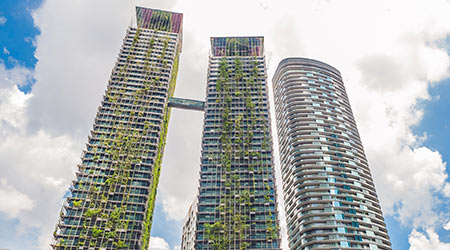
The U.S. Green Building Council (USGBC) recently brought to light several new studies that support the business case for LEED. In each study, researchers did a deep dive into energy-related and economic outcomes for LEED and Energy Star-labeled buildings in comparison to non-labeled. The results: Both are reliable indicators of high-performing buildings, and the market continues to value these labels in financial terms.
In "The effectiveness of U.S. energy efficiency building labels," researchers from UCLA and Georgia Tech analyzed monthly energy consumption data from over 175,000 commercial buildings in the city of Los Angeles for the period 2005–2012. Focusing on the buildings involved in three programs: LEED, Energy Star, and the Better Buildings Challenge, the researchers used matching strategies to compare performance of participating buildings to similar non-participating buildings.
Researchers found “high magnitude” energy savings for all the programs, ranging from 18–19 percent (Better Buildings and Energy Star) to 30 percent (LEED). These savings represent a reduction of 210 million kilowatt-hours, or 145 kilotons of CO2-equivalent emissions per year. The study also reinforces the need for additional policy interventions to support energy saving activity in smaller and Class C buildings, which were less likely to participate in the building label programs.
The second study comes from Nils Kok, longtime researcher of market valuation for green buildings and other indicators of sustainability, and Rogier Holtermans, of the University of Southern California. "On the Value of Environmental Certification in the Commercial Real Estate Market" focuses on office buildings in the 30 largest U.S. commercial real estate markets, finding that nearly 40 percent of spaces hold some kind of environmental certification in 2014, as compared to less than 5 percent in 2005.
Tracking some 26,000 office buildings, they measured the performance of real estate in 2013. Environmentally certified office buildings, on average, continue to have higher rental, occupancy and pricing levels, corroborating the results of earlier work. For the single metric of rental growth over time, they found no statistical difference. The authors conclude that, as a policy approach, credible energy and sustainability labels such as LEED provide a relatively low-cost strategy for differentiation in the commercial building stock, leading to increased energy efficiency.
To learn more about the business case for LEED, click here. To access the studies, click here.

 The Down and Dirty on Cleaning in Virus Season
The Down and Dirty on Cleaning in Virus Season How Surfactant Use is Expanding in Commercial Cleaning
How Surfactant Use is Expanding in Commercial Cleaning Clean Buildings Conference
Clean Buildings Conference